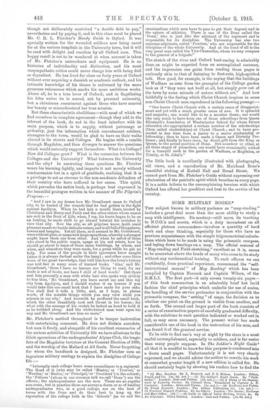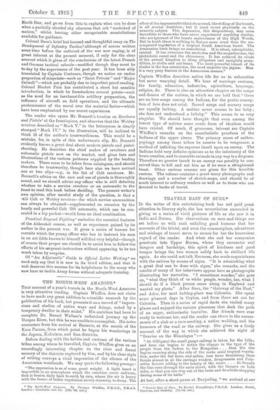SOME MILITARY BOOKS.*
TREI subject known in military parlance as " map.reading " includes a great deal more than the mere ability to study a map with intelligence. Its mastery—still more, its teaching to N.C.O.'s and scouts, which is a duty incumbent on all efficient platoon commanders—involves a quantity of hard work and clear thinking, especially for those who have no previous acquaintance with the simple trigonometrical calcula- tions which have to be made in using the prismatic compass, and laying down bearings on a map. The official manual of "Map-reading and Field-sketching," excellent as it is, seem' to be somewhat above the heads of many who come to its study without any mathematical training. To such officers we can confidently, from practical experience, recommend the "self- instructional manual" of Map Readingl which has been compiled by Captain Norcock and Captain Wilson, of the R.M.L.I. The first part—it only covers twenty-six pages— of this book summarizes in an admirably brief but lucid fashion the chief principles which underlie the use of scales, the handling of the service protractor in conjunction with the prismatie compass, the " setting " of maps, the decision as to whether one point on the ground is visible from another, and so forth. The second and larger part of the book consists of a series of examination papers of carefully graduated difficulty, with the solutions to each question indicated or worked out in full, as may seem necessary. The present writer has made considerable use of the book in the instruction of his men, and has found it of the greatest service.
To be able to find one's way at night by the stars is a most useful accomplishment, especially to soldiers, and is far easier than many people suppose. In The Soldier's Night Guide 2 all that it is needful to know for this purpose is condensed into a dozen small pages. Unfortunately it is not very clearly expressed, and we should advise the author to rewrite his work at somewhat greater length if a new edition is called for. He should certainly begin by showing his readers how to find the • (1) Map Beading. By L. Norma and P. S. Wilson. London, Bitten., Freed, and Co. [4e. ad. net.1—(2) The Soldier's Night Guide. By "Path- finder," London: Gale and Poiden. [ad. not.]—(5) A Study of the Dsoertop• moat of Infantry Tactics. By Colonel Beea. Translated by Captain A. F. Custanee. London : Allen and Unwin, [is. net.]—(4) Bevoluors and Pistols. By Frank Bennett. London : The Aldine Publishing Co. Las. net,]— (5) Practical Bayonet Fighting. By An Officer. London r The Bawer, Exch.:owe and Mart Office. [6d.1—(6) Guide to Ogloial Letter Writing, Orders, do. By An Adjutant. Third Edition, Lon4ua Cale and Polden. [Is. ad. net.] North Star, and go on from this to explain what can be done•when a partially clouded sky obscures that orb " unehaked of motion," whilst leaving other recognizable constellations available for guidance.
Colonel Beca's brief but learned and thoughtful essay on The Development of Infantry Tactics,' although of course written some time before the outbreak of the war now raging, is of great interest at the present moment, if only for the clear account which it gives of the conclusions of the latest French and German tactical schools—modified though they must be to-day by the experiences of the past year. It has been ably translated by Captain Custance, though we notice an undue proportion of misprints—such as "Saint Private" and "Major Calwell "—which are probably due to imperfect proof-reading. Colonel Racket Pain has contributed a short but sensible introduction, in which he foreshadows several points—such as the need for an inexhaustible artillery preparation, the influence of aircraft on field operations, and the ultimate predominance of the moral over the material factor—which have been emphasized by our recent experiences.
The reader who opens Mr. Bonnett's treatise on Revolvers and Pistols' at the frontispiece, and observes that the Webley revolver described as "Mark V." in the letterpress is clearly stamped "Mark IV." in the illustration, will be inclined to think ill of the author's trustworthiness. This would be a mistake, for, in spite of this unfortunate slip, Mr. Bennett evidently knows a great deal about modern pistols and pistol- shooting. He describes the chief makes of revolvers and automatic pistols now on the market, and gives lists and Illustrations of the various patterns supplied by the leading makers. These seem to be taken from catalogues, and should therefore be trustworthy, though here also we have noticed one or two slips--e.g., in the list of Colt revolvers. Mr. Bonnett's advice on the care and use of pistols is thoroughly sound, and we should advise any officer who is still debating whether to take a service revolver or an automatic to the front to read this book before deciding. The present writer's own opinion, after careful study of the question, is that a -465 Colt or Webley revolver—for which service ammunition can always be obtained—supplemented on occasion by the bandy and powerful Colt .390 automatic, which can be con- cealed in a hip pocket—would form an ideal combination.
Practical Bayonet Fighting' embodies the essential features of the Aldershot course, as well as experience gained by its author in the present war. It gives a aeries of lessons for recruits which the young officer who has to instruct his men in an art little known to himself will find very helpful—though of course their proper use should be to assist him to follow the efforts of his sergeant-instructors without appearing to be too much taken by surprise.
Of "An Adjutant's" Guide to Official Letter Writing we need only say that it is now in its third edition, and that it well deserves this success for its helpfulness to the many who now have to tackle Army forms without adequate training.















































 Previous page
Previous page